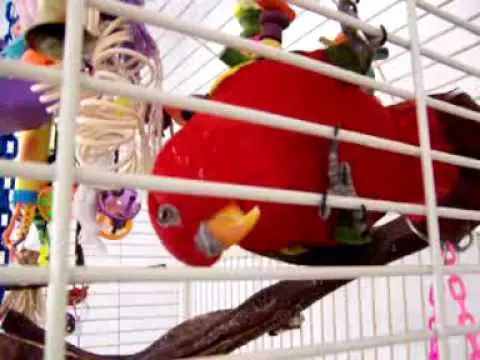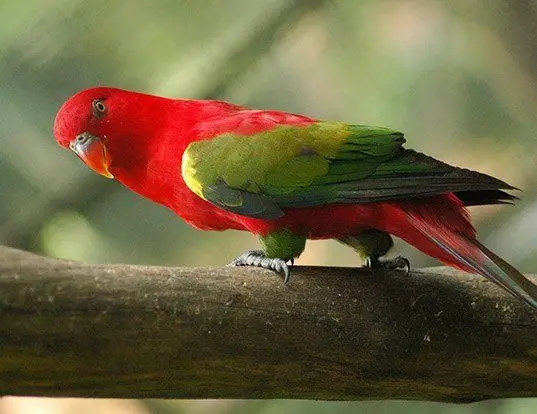Scientific Facts
| Common Name: | Chattering Lory |
| Scientific Name: | Lorius Garrulus |
| Life Span: | 28-32 years |
| Size: | 30 centimeters (11.7 in.) |
| Habitat: | Rainforest areas |
| Country of Origin: | North Maluku Indonesia |
Overview
These birds in the eastern hemisphere are distinct and endangered parrots, and yet they are fascinating. Their unusual personality matching with an appealing and amazing coloration is what makes them extraordinary. The Chattering Lory is one of the most parrot breeds that people are seeking.
Aside from having a complexion with their personality and coloration, they also have the usual behavior that will reach the taste of bird loves when it comes to lories. In addition to that, they are fun and energetic behavior that will surely capture the hearts of their owners. They possess contagious affection that makes their owners love them more.
Physical Description
The chattering lory’s size is 30 cm or 12 in. Their color is mostly red with an all-red head, and they have an orange beak. The eye rings of these birds are grey, and their irises are orange-red. Mainly green is the color of their wings, and the wing’s angle is yellow. Its thighs are green. The tip of the tail is dark green, and their legs are dark grey. It depends on the subspecies, for it may or may not have a yellow area on their backs.
The Chattering Lory, at first glance, is largely just like their close cousins in the Lory family of parrots. The Lory species share the short conical tail, the small beak, and the distinct eyes are. But then, they have their distinct trait, and one major difference is that they have their color.
Sub-species and Distribution of the Chattering Lory
- Yellow-backed Lories or Lorius Garrulus Flavopalliatus- they exactly look like the Chattering Lory, but only, they have a yellow patch on their back. They are found in Batjan and Obi Islands that is part of the Maluku Islands
- Morotai Yellow-backed Lories or Lorius Garrulus Morotaianus- they also look like the yellow-backed Lories, but they differ on the yellow patches which they have smaller and less far-flung.
Chattering Lories as Pets
Since they are an endangered species, they are desirable to give them a well-organized breeding program that is well-managed to guarantee the continuous survival rate of these species because that was anyone must do when it comes to any specimen that cannot be released back to their natural habitat.
Chattering lories love to cling with their owners and spend much playing inside their cages during the days. They are messy most of the time, but their outgoing personality more than makes up for it, and that’s what makes them actively wonderful.
The colorful chattering lory is the most popular type of lory. They are named chattering lory because they generally chatter all day long. They are becoming loud in the morning for a short time after sunrise and during the evening before lights are turned off. Since all lories are the master of mimics, they can even be loud during a noisy period like they rival with amazons with their noise output’s quality. And make sure you have their feathers clipped to avoid them gliding in the ceiling because lories love to fly.
Native Region or Natural Habitat
The native region of these parrots where they are dominant is in the Halmahera and Weda Islands, which is part of the North Maluku group of Islands in Indonesia. The said province is consisting of a few islands in the Maluku archipelago.
Their small natural habitat is prone to excessive trapping for illegal trade results in losing and descending of populations. That’s the main reason why the Chattering Lory is calculated to be an endangered breed. They are commonly found in local montane forests and live in canopies.
Behavior or Temperament
For they are sweet, the Chattering Lories are popular. They have a playful personality that can entertain you enough with tricks, and they are known for being intelligent. Having your bird properly trained and guided their behavior accordingly is recommended.
Here are the behavior qualities of a Chattering Lory:
- They have an energetic and playful personality, so you won’t have any dull moment with your adorable pet.
- You will love the new games and tricks played with your bird, and you’ll see that you have a happy pet in your arms.
- They love to cling to their owners, which is their favorite human in the house, so expect some cuddling time occasionally.
- They may be messy at the same time, but they have an outgoing personality.
- Chattering lories are unique in their own way that entertains people and are good pets.
- They are highly sociable depending on the interaction, so spend more time and provide a lot of attention.
Speech and Sounds
Chattering Lory may not be that unpleasant bird when it comes to noise; they have this high pitched tone that you can rarely hear in a day. Consider that as their calling. That may be the reason why Chattering Lorries qualified in the house or in aviaries outside the house.
Lories are the master of mimics; that is why they have their natural way of trick for impersonations, and you will be surprised because they are accurate on doing it. They are also fond of the telephone rings, whistles, and alarms, even the common sounds of other animals.
Housing

When putting up a cage for your Lories, put up in mind that you must have a lot of rooms because they will surely need space with the activities you will provide for they are a dynamic and highly sociable parrot. The size of the cage should be more on width so that the birds can freely spread their wings. They are medium-sized parrots, so they require you to provide a cage with at least 18” by 18” by 22” high. Maintain cleanliness in their cage; it is also best for it to be hosed down because their feces are almost liquid than of the other parrots out there.
For they are intelligent birds, you must give them a nice environment with a lot of toys. Even not so fancy toys can be enjoyed by Chattering Lories. But they need a variety of toys such as wooden blocks, mirrors, bells, and swings, they do even like empty tissue rolls and simply a paper bag. And most important of everything is their branches so that they have something to exercise their feet, but make sure to fit it in the cage where it is not above the food or water to avoid contamination in case there may be droppings from it.
Diet
The majority of the diet of Lories takes in flowers, nectars, fruit, pollen, and some seeds and insects. They advise a pelleted diet for lories at home and to add variety, mix it with fresh veggies and fruits daily. Supplement them with food with iron such as legumes, eggs that are chopped and cheese. But do not give them foods that are high in iron from animals like meat scraps. They also enjoy having rice, potatoes, and different kinds of pasta. It’s just like a treat for them from your table.
Avoid giving them foods that can cause diarrhea like veggies such as cabbages and tomatoes, sweets like chocolate, soda, an avocado that can be poisonous. It is important to wash their fruits and veggies before you hand it to them.
How to Address Your Lory’s Screaming
Chattering Lories are high-pitched birds, and most of the time, during sunrise and sunset for they celebrate it as what the other birds also are doing. By screaming, they communicate with people. It can also be a sign of danger where they scream because they are afraid. It also shows when a bird is healthy or do they have some illness, that is why you check them from time to time.
Here’s how to address when your lory is screaming:
- Ignore your parrot when screaming; do not walk over them; instead, leave the room.
- Do not give them food or toys because that just means you are rewarding them, and it will just keep them on scream more.
- Do not encourage any screaming, even just the smallest, so that they will stop eventually.
- It is good to play or teach some tricks and train them to fly to divert their screaming Spending their energy to something rather than screaming makes them calm and quieter.
Teaching Your Lory to Talk

Video URL: https://www.youtube.com/watch?v=RwRIBvozd5Y
It is best to set your bird’s mood in a good mood, and you must have a friendly ambiance so that your bird won’t be shy, Make sure that you know your bird and the bird knows you as well to build that trust.
Birds should also follow the routines made by the owner so that when it is still young, they are already learning. Set a good ambiance first before starting to teach your lory to talk. Every time you enter and leave the house, you must say a word or a simple phrase so that they will be able to mimic it.
Here are the things you need to consider when teaching your lory how to talk:
- Good Health: Being healthy is to reach the bird’s full potential to talk. Therefore, they should have proper body health conditions by giving them the right amount of food and some supplements and a good environment.
- Intelligence: Lories are smart. They are able to mimic sounds and phrases.
- Love and Trust: They only talk when trust and love are built between him and his owner. If these traits are absent, then the lory will not say any single word.
- Care, Patience, and Time. Giving more time and showing affection can lead them to faster learning.
- Daily Routine: Making routines make birds feel happy and safe. Aside from eating and playing, lessons should be a part of their schedule of that routine.
- Young Birds: Ages from 2 to 5 years old. Younger years are the easiest time for the birds to learn. This time they learn their parent’s language.
Lessons
First Lesson
You need to show your bird your affection and make them feel the warmth coming from you. 1st step is by tickling their neck the same way how their parents trained them in their nest. It’s an act of giving them a love signal. By capturing their hearts, you can now teach birds to say basic and simple words.
Like when you are going to tickle their neck, you whisper “I love you” so that the bird will take that act as a token of love. You say “kiss” as you kiss their beak, and the bird will feel you show them your love. Do it as much as possible until your bird can make certain words and actions. And after, teach them by mentioning their names so that they are aware of themselves.
Second Lesson
After teaching basic words and gestures, you now get into deeper their cognitive behavior.
- You simply say words good morning and goodnight during the time of the day; address foods they are going to eat, especially their favorites.
- Teach them the basic actions as what they are expected to do with their branches like hop or come to go near to you or your arms and “scratch” when you are going to do it to them.
Third Lesson
Now, this is the finale where you are going to let them learn while listening and watching. Lories usually get jealous when their owner is talking to the phone. And that is one of the teaching tools for the lory. So now, what they will do is to get the attention of a member of the family and will do or say what the bird was observed.
Availability: Where to Get One?
For those who want to have Black Lory, you can visit pet shops and if there’s available Chattering lory. If not available, then you may search online sites and see if they are selling this bird.
How to Care
Showering them daily is important to maintain their skin condition. Some birds want to wash in a birdbath or sometimes in a bowl. Place it in their cage every after few days for only half an hour. And the best way to dry themselves is under the sun or in a dry room.
- Choose a huge cage for lory. The bigger the cage, the happier your lory will be. Provide your lory a lot of toys, food and water dishes, perches, and wide space for them to spread their wings freely. You should have water and food on both sides. The branches should not be so near the food containers so the food won’t be contaminated in case they will scratch it. It should be moved outdoors for fresh air and sunlight.
- Give them two weeks allotment before introducing them to their new cage to adapt naturally.
- Give them a good foundation for their health by having a well-balanced diet. You can give them soft fruits and nectars. They usually don’t eat seeds. Some nectar replacements are available in the market. Mix their fruits and vegetables with some vitamins into their water every 2 to 3 days.
- Once they take their first bath, they won’t be able to get enough of it, so avail them of their favorite toys. Take the leftovers and old food inside the cage regularly. Change their water daily.
- Have your birds take vitamins in several weeks every six months.
- Parasites are likely to attack birds. Kill them with lice and mite spray. When you spray, it must be on everything inside the cage, even the bird, but make sure to avoid spraying on their eyes.
- Train them in a calm state. Spend more time with your bird until you get their love and trust and avoid giving them stress after taking them home.
- Breeding. Both sexes look the same. They breed easily and get mature 8 months later.
Keeping Your Lory Safe, Happy and Healthy
- Give them attention.
- Provide them fresh and pesticide-free, including fruits and vegetables.
- Make sure that they have clean and fresh water. Daily, change the water and food containers.
- Spoil them sometimes by bathing or showering.
What a Veterinarian Looks for in a Healthy Lory
- Dry and open nares,
- Clear and bright eyes,
- Alert and erect posture,
- Smooth beak,
- Body free from bumps or lumps,
- Smooth and bright feathers
Common Disorders of Lories
The majority of these diseases are due to malnutrition. It is advisable to bring your pets to the vet regularly to prevent diseases such as the following:
- Hemochromatosis
- Fungal infections
- Liver disease
- Circovirus
- Reproductive disorders
- Parasites
- Obesity
- Injuries
- Bacterial infections
Treating Beak and Feather Disease
Recognizing the Symptoms
1. Look if there is some bleeding on their missing feathers on the wings and tail, especially for feathers that fall out so easily. If your bird is infected, it affects the bird’s flying ability; it will not fly well.
3. See if there’s any discoloration; therefore, you must know your bird’s coloration, especially on their yellow feathers, and check if the tails or feathers have any yellow patches.
4. A drop in bird’s vocal activity could mean something so monitor if they are depressed.
5. Observe for secondary symptoms like vomiting, difficulty in eating, loss of weight, and green mucus.
6. Have your bird undergo a test.
Treatment/Prevention
1. Separate the infected birds for at least 2 months with enough distance to prevent being harmed.
2. Give nutritional supplements to somehow suppress the virus. But still, isolate them from infected ones.
3. Heat them with an infrared light because feather loss can lower the body temperature of the bird.
4. Take your bird to the vet to treat the secondary infections.
Preventing Psittacine Beak and Feather Disease or PBFD
PBFD is a viral disease affecting all parrots by infecting and killing the cells of lorries’ feathers and beak. Also, the virus also attacks the immune system. The acute form of PBFD is obvious when the bird is vomiting and has diarrhea, loss of appetite, and lethargic.
Here are some tips to avoid PBFD:
- Quarantine the new arrivals for two months.
- Disinfect your whole house. Clean the whole area first and then apply a concentrate. Let it remain for 10 minutes. Then, rinse well.
- Free your home from dust by using air cleaners and vacuums because diseases tend to be transmitted by infected dust
- If possible, have your birds vaccinated.
FAQ Section
How long do lory parrots live?
One type of parrot can live 20 to 30 years.
Why parrots live long?
They are special among all the other birds. Parrots live longer if they are pet birds because they don’t encounter predators and diseases, unlike in the wild.
Can lory birds talk?
Yes, they can talk and have a good vocabulary.
Why do parrots mimic?
When they are kept as pets, they learn their call with their owner. They can be taught different things and can learn what people do inside the house.
How do parrots die?
The two main reasons why birds die is first because of malnutrition because people tend to give them all seed diet, but it should only be part of their diet. Another reason is accidents.
Can a parrot die from stress?
When they reached their extreme stress level, they break and pull out their feathers that can cause a big amount of blood loss and can be infected.
Why do parrots repeat?
They are masters of mimics.
Can parrots die from colds?
The fact is they can survive in cold temperatures. They will fluff their feathers to trap the heat coming from their bodies.
Do birds cry?
They do. They have tear ducts that secrete tears that protects the eyes.
Do parrots understand what you say?
Yes, according to owners of parrots. They are that intelligent that they can attach meaning to some words.
Can birds die from overeating?
They have a high metabolism, so a night of hunger is okay, but more than that can be dangerous.



